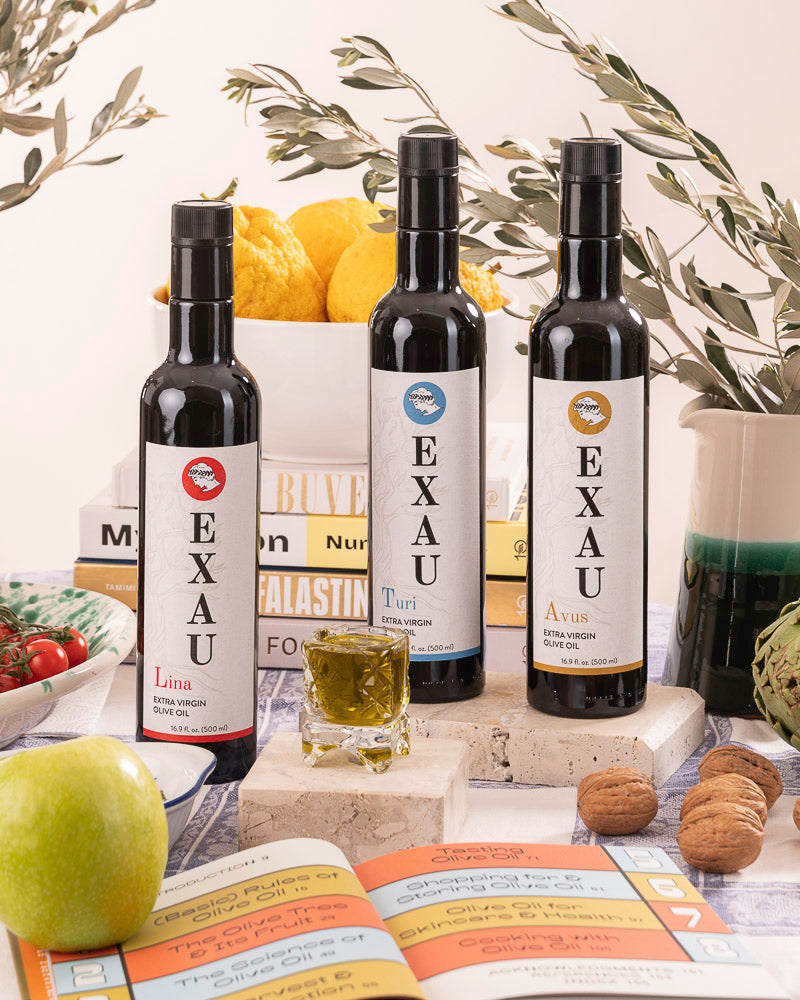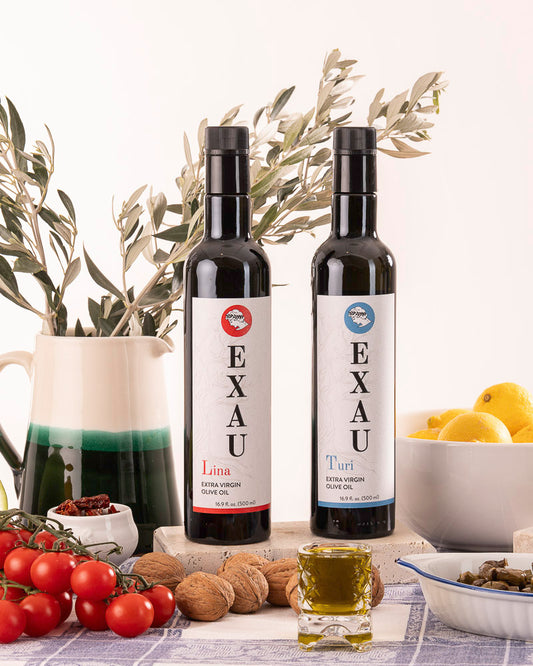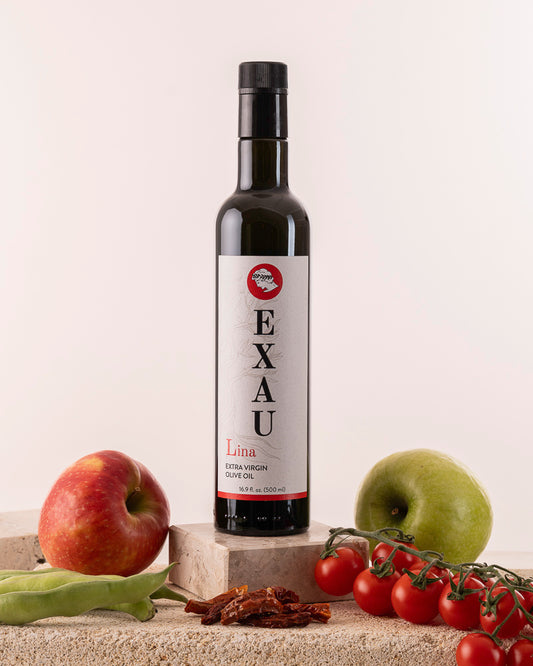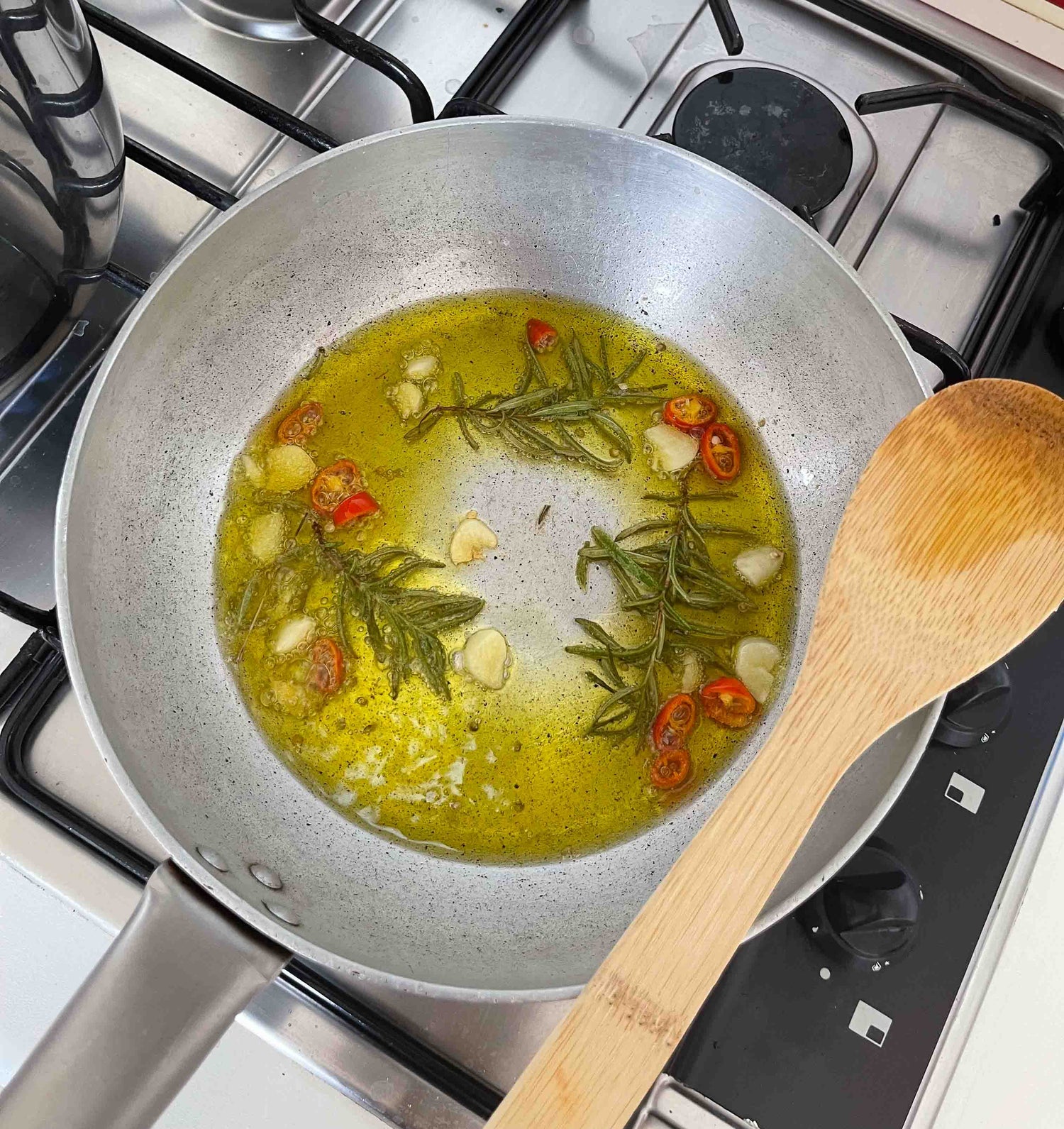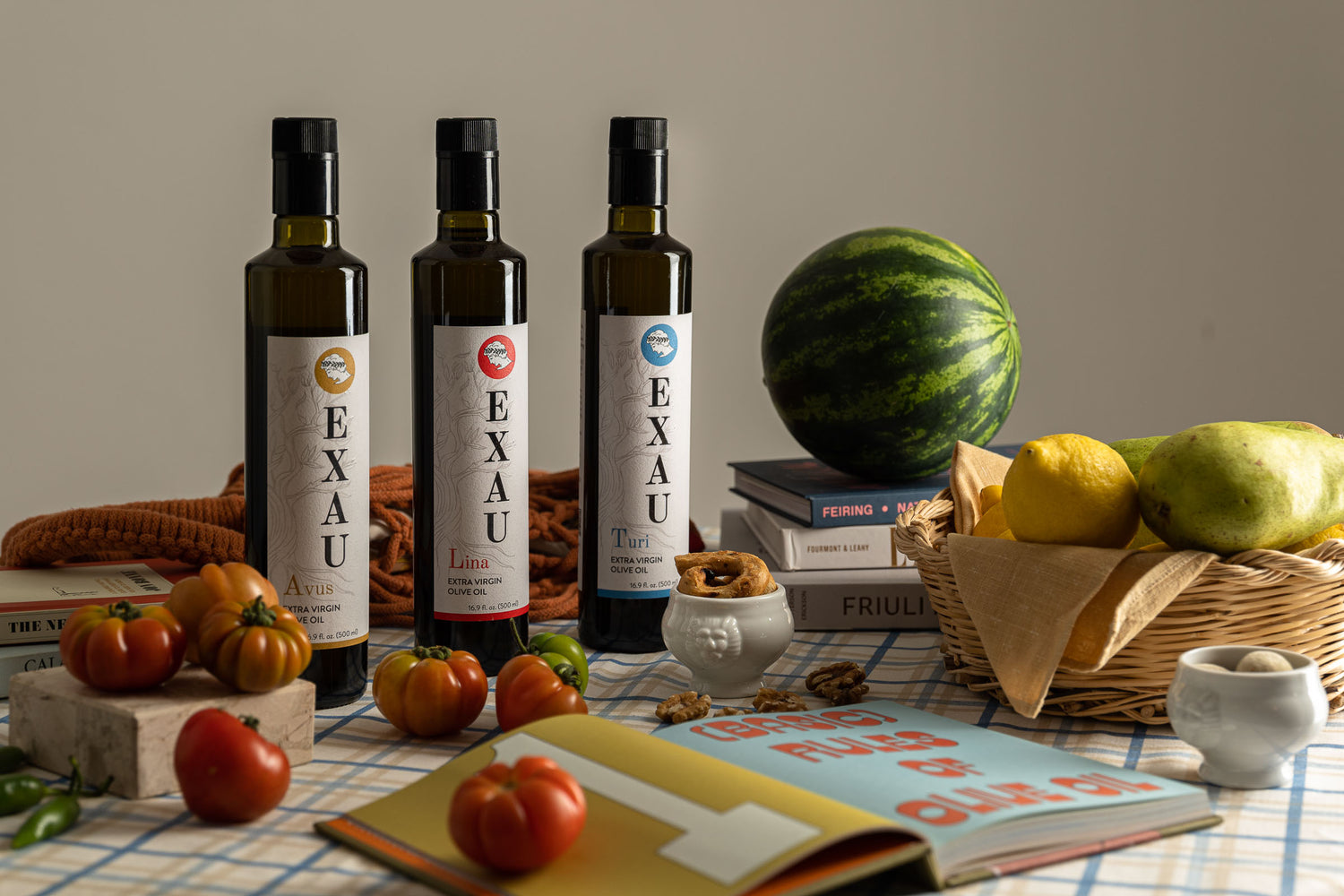Olive oil tasting, also known as sensory analysis, is the process of evaluating the aroma, taste, and mouthfeel of an oil to determine its quality and flavor profile.
It's skill that takes time and practice to develop. But once mastered, it can open up a whole new world of culinary possibilities.
In this guide, you will learn how to taste olive oil as we walk you through the process step-by-step and give you the tools you need to become an expert.

How to Taste Olive Oil
Fill a small cup or a tasting glass with at least 1 tbsp of extra virgin olive oil. Cover the cup and heat it gently with your hand. Uncover it and take a big sniff, evaluate the smell. Then take a generous sip letting the oil fully coat your mouth, evaluate again.
As the producers of high-quality Italian extra virgin olive oil here at EXAU, we can tell you first hand that there are dozens of factors that impact the harvest and production of the product.
This means the taste, aroma, and quality of an EVOO can vary greatly. Some of these contributing factors include but not limited to the cultivar (type), region where the fruit was grown, time of harvest, and the milling method.
When tasting it's important to keep an open mind. Consumers have been told for the past decade that extra virgin olive oil should be 'grassy, herby, and buttery' but only a few cultivars actually have those flavor profiles.
If you smell or taste flowers, berries, plum, oregano, or some else don't be shy.
Important Steps
Use a tasting glass: In the industry, we use small, tapered blue glass cups to evaluate aroma and taste. The shape of the glass can help concentrate the aroma and make it easier to detect.
Smell: Before tasting, give the product a long sniff. Take a moment to analyze what you just smelled. You might pick up some familiar scents. Try to identify them.
Sip: Take a small sip and let the oil coat your tongue and mouth. Try to detect the different flavors and textures, such as bitterness, fruitiness, and pungency.
Evaluate the Finish: After swallowing, pay attention to the aftertaste or finish. Does it linger on the tongue, or fade quickly? Is it pleasant, or does it leave a bitter or unpleasant taste?
Ask what others smell or taste and discuss the mouth feel. Remember, this is a subjective experience, so others will likely have picked up different notes. It's fun to compare notes with others!
For more about tasting grab our book: The Olive Oil Enthusiast.

How to Prepare for an Olive Oil Tasting
If you want to host a fun tasting party then prepare the same way you would a happy hour or cocktail hour at home. Set out cheeses, bread, wine, and more. But above all else make sure you have many small clean, unscented cups.
Create a space where you can conduct the actual tasting. The kitchen island, dining room table, or other large flat surface where folks can gather and listen work really well.
This space should also be clear of heavily scented food, perfumes, and candles.
Try to do the tasting before guests have a chance to start eating heavily scented or strong foods such as blue cheese, salsas, or cocktails. We want folks to have a neutral palette.
Gather them around the table and set the first cup before them then guide them through the process outlined above: smell, sip, evaluate.
Then place a fresh cup with a new oil before each guest and continue. This should be a fun and interactive activity!
Evaluating Quality
It's important to give tasters space and time to evaluate each product. This might mean long pauses before moving on to the next step. Or moments of silence while they evaluate flavor profiles. This is all completely normal.
Proper tasting does require some mental gymnastics because everyday consumers don't try to identify every single flavor profile they come across when eating.
If someone is struggling to put their thoughts or flavors into words throw some terms out there and see if they latch on.
Here are some flavors and terms to help you get started:
- Green grass, yellow hay, lettuce
- Artichoke, chicory, bell pepper, spicy pepper
- Vanilla, banana, chamomile, plum
Related: A Guide to Italian EVOO

The Key Factors of Tasting
There are several key factors that can influence the sensory profile and quality of an EVOO. Some of these include:
Cultivars
Different olive cultivar have different flavor profiles. These can range from mild and buttery to fruity and vibrant to bold and peppery. Cultivars also tend to have certain characteristics or traits.
For example, the Carolea tree, which is native to Calabria, often produces an oil with notes of green grass, apple, almond, and artichoke. These flavors are common for Carolea and highly sought after by producers and consumers.
However, this doesn't mean other flavors don't show up. For example, our Turi is produced with Carolea and sometimes has notes of tomato leaf.
Terroir
Terroir is the way elements such as sunlight, elevation, soil, and climate impact fruit such as grapes.
The word is usually used to discuss grapes and wine. However, terroir can also be applied to the world of olive oil. Afterall, the soil, climate, and sunlight changes based on geographical location no matter what you grow.
Therefore, a farmer in Calabria growing Carolea and a farmer in Puglia growing Carolea are going to produce completely different olive oils although the fruit might come from the same exact tree. This is the beauty of terroir!
Harvest Time
The time at which the fruit is harvested also greatly affects the taste and quality of the final product. Olives harvested earlier in the season tends to produce oil with a more robust, bitter flavor. While fruit picked later in the season produce oil with a milder, fruitier taste.
Some believe early harvests are better, however, this is a personal preference because taste is subjective. It is important, however, to be able to tell the difference between the two if you want to better understand the product.
Production Methods
The way in which the fruit is milled can also have a significant impact on the taste and quality of the product. Freshly harvested fruit that sits in the sun or in bins for extensive periods of time before entering the mill can develop several undesirable characteristics.
This includes increased free fatty acid, increased peroxide, and negative sensory notes such as mustiness and fustiness.
Meanwhile, fruit that is harvested and milled quickly is more likely to be free of defects.
Storage Conditions
The way in which bottles or tanks are stored can also affect overall taste and quality. For example, exposure to light, heat, and air can all cause the product to oxidize and lose its flavor over time.
Read more about proper storage practices at home here.

What Products to Get
Buy a few high quality EVOOs for your tasting. We highly recommend our Tre3 which includes three different types of oil: The Avus, Lina, and Turi. This will allow you to try several different high-quality products.
It's also a good idea to also taste one or two low quality products. This can be an everyday cooking oil you have on hand or a bottle that someone brings for the purpose of comparison. This allows you to taste the difference between the two categories.
What should I look for when buying product for a tasting?
Make sure the product says 'extra virgin' on the front. Also check the back of the bottle for a harvest date, lot number, and country of origin (preferably a region).
The name of the producer is a huge bonus. It's important to know exactly where the product is from and have some knowledge of the producers and their values.
Is it necessary to buy expensive olive oil for the tasting?
It's best to get a mix of products, both expensive and inexpensive. With that said, it's important to note that good EVOO doesn't have to cost an arm and a leg. There are many affordable options.
However, for a well rounded tasting it's best to have products with different price points and of different qualities. This helps tasters build the skill of identifying high-quality products vs regular products.
Can I use flavored olive oil for the tasting?
For a true tasting, it's better to exclusively use extra virgin olive oils. Some flavored products can contain oils that aren't from the olive fruit.
Alternatively, you could use one flavored, one regular, and several extra virgin olive oils. This would help build the tasting group's skill of identifying products that are not pure extra virgin.
Related: Regular vs Extra Virgin, What's the Difference?
How long should the tasting last?
The tasting can last as long or as short as you'd like. It depends on how many products you taste and if you also do food pairings.
To simply taste olive oil out of a glass the process is very straightforward and can take as little as 2 minutes per product. However, if you talk about the producers, production methods, and more it can take around 5 to 10 minutes per oil.
If you also include a full tasting menu, featuring each product, a tasting can easily last 2 hours.
Shop our collection of premium Italian EVOO online today!
You might also like...
Pssst, we wrote a book called The OO Enthusiast, have you ordered it yet?
If you learned something new or have opinions on this topic, please leave a comment and let us know your thoughts! We love to hear from you. If you’re on Instagram, TikTok, or Facebook don’t forget to tag us and use #EXAUoliveoil so we can repost!
